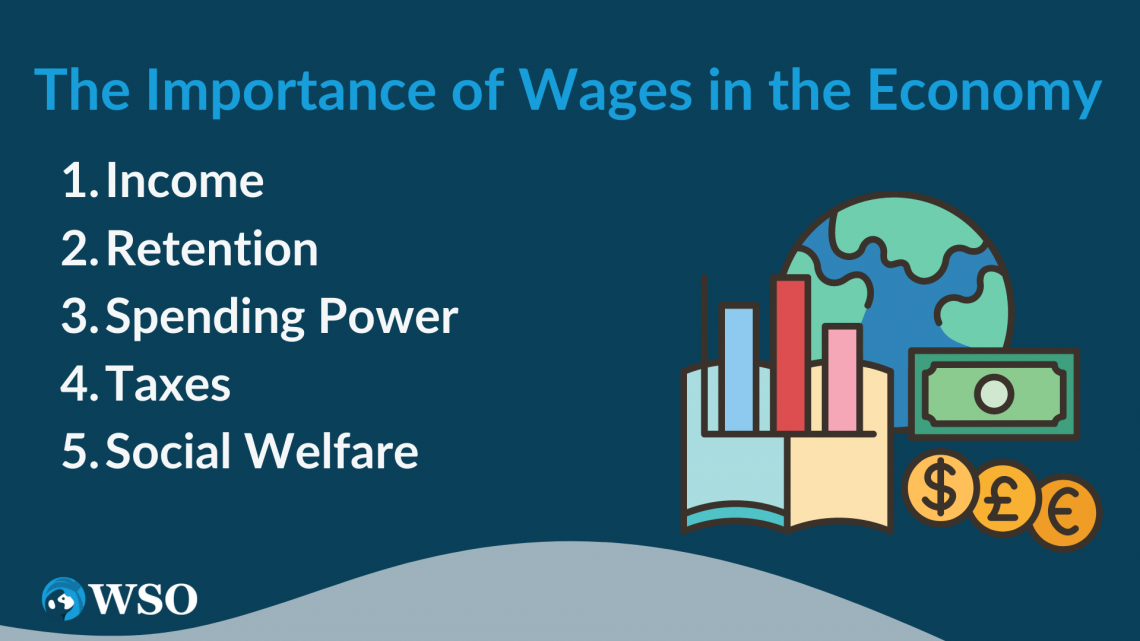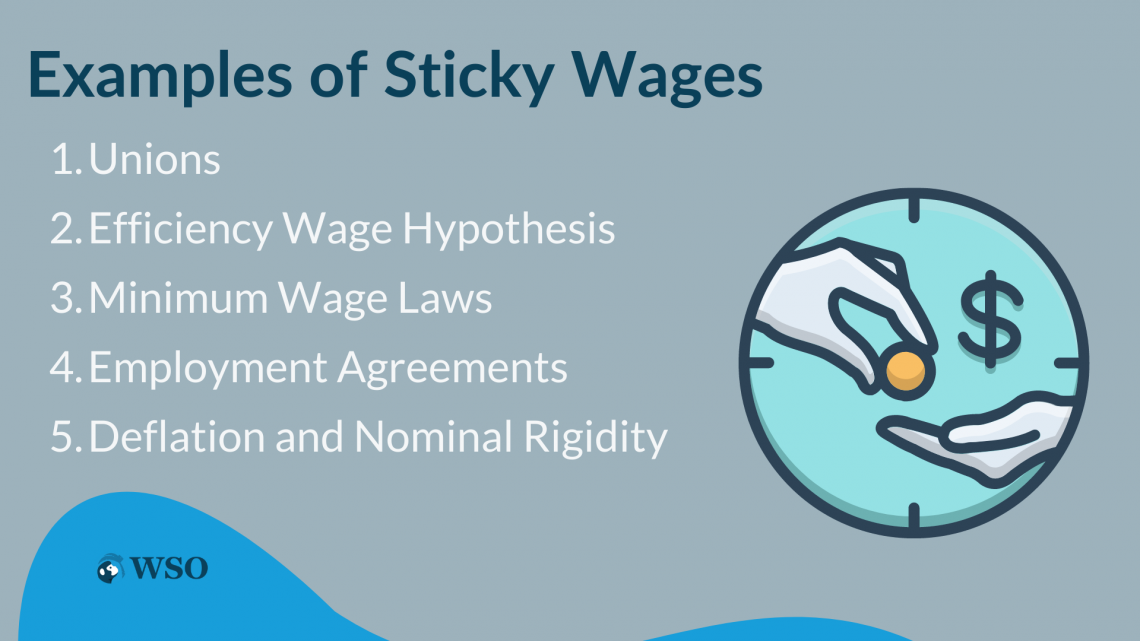Sticky Wage Theory
According to the sticky wage theory, changes in employee pay are typically slow to reflect changes in business performance or the state of the economy.
According to the sticky wage theory, changes in employee pay are typically slow to reflect changes in business performance or the state of the economy.

The idea holds that instead of declining in line with the decrease in demand for labor when unemployment rises, the earnings of those employees who remain employed often stay the same or grow more slowly.
In particular, wages are sometimes described as sticky-down, suggesting that they may quickly move up but can only slowly down.
The economist John Maynard Keynes is credited with developing the theory, calling the issue "nominal rigidity" of wages. Firms cannot immediately raise wages, causing temporary profit increases if wages are inflexible.
When a certain nominal price resists change, a theoretical market condition known as "stickiness" occurs. Stickiness, often known as price stickiness, is a term that is frequently used to describe market prices, even though it often refers to salaries.
Due to an imbalance between pricing rigidity and flexibility, the overall price level, or average level of prices within a market, can become sticky.
Because of this imbalance, prices frequently react to pressures that cause them to rise but resist those pushing them down. As a result, levels will not react as fast as they normally would to significant economic downturns.

Many economists agree with the popular hypothesis of wage stickiness. However, some purist neoclassical economists question its viability. The theory's proponents have offered several explanations for why wages are sticky.
These include the notion that employees are considerably more likely to accept salary increases than decreases. In Keynesian and New Keynesian economics, stickiness is a common issue.
Without stickiness, salaries would always fluctuate with the market in a more or less real-time manner, creating a reasonably stable economic equilibrium.
A market disruption would result in corresponding wage decreases without significantly losing jobs. Instead, because of stickiness, firms are more likely to reduce employment, and earnings are more likely to stay the same in the case of a disruption.
- According to the sticky wage theory, changes in employee pay are typically slow to reflect changes in business performance or the state of the economy.
- Without stickiness, salaries would always fluctuate with the market in a more or less real-time manner, creating a reasonably stable economic equilibrium.
- In a labor market that is competitive, supply and demand should have an impact on salaries. Employers & employees alike, though, frequently oppose salary reductions.
- A key shortcoming is its inability to effectively explain why earnings vary between industries and geographies.
- Sticky wage theory has also come under fire for failing to account for changes in the labor market over time.
- Real wages fall when inflation takes place, which lowers the demand for labor. It assists in the gradual equilibrium of the labor market.
The Importance of Wages in the Economy
Several reasons explain how wages are a vital aspect of the economy. Some of them are:

1. Income
Along with other minor sources like government assistance and investment income, salaries are the main source of revenue for workers.
Work-related wages cover necessities, including rent, a mortgage, food, and utility costs. Higher-paid employees can afford more luxurious lifestyles than lower-paid employees.
2. Retention
Wages are a crucial retention strategy for organizations. Payroll costs can be reduced by offering low compensation, but employees will be less likely to depart for positions elsewhere if their pay is more competitive.
Pay provides a means of reward, such as when an employer gives a performance bonus or increase based on a performance review.
Wages can impact workplace morale because employees who are paid a fair salary are more likely to feel valued by their employers.
3. Spending Power
Since wages give workers purchasing power, they significantly impact the economy.
This includes the money employees earn and spend on needs and the money they save or utilize immediately for things like consumer items, entertainment, vacation, and investments.
By supporting businesses that produce goods, sell them, provide services, and manage money, as well as the financial institutions that do so, workers' earnings help to create jobs elsewhere.
4. Taxes
Governments receive tax money from wages as well. Employees' taxable income and tax rate increase as their income increases.
Unemployed taxpayers must declare their unemployment benefits as income, but due to benefit limits, unemployed individuals pay less in state & federal taxes than those with permanent jobs.
Higher wages, which happen in industries with intense competition and high worker demand, increase government revenue and give more financing for services and new initiatives.
5. Social Welfare
Social welfare is greatly affected by the distribution and level of wages. Social and economic gaps arise from wage inequality, whereas low wages or rampant unemployment is the breeding ground for poverty and social upheaval.
Wages serve a critical function in the economy. They are needed to provide income and allow consumers to have the ability to spend money.
Thus allowing the country's GDP to increase and businesses to make money, which will then be used to pay employees.
Examples of Sticky Wages
In a competitive labor market, supply and demand should impact salaries. Employers & employees alike, though, frequently oppose salary reductions. The fact can be explained in many ways:

1. Unions
Due to their collective negotiating power, employees in unions can fight against salary reductions. Even if some unemployed workers are willing to accept lesser pay, union members who are currently employed can reject any proposed pay reductions.
2. Efficiency Wage Hypothesis
According to this hypothesis, paying employees more can boost their morale and make them loyal to the business.
In exchange, employees are eager to put in more effort and produce more. Employees' psychological well-being may suffer when pay is reduced, reducing productivity.
3. Minimum Wage Laws
Due to minimum wage laws, employers cannot reduce salaries below that amount.
4. Employment Agreements
Since wages are frequently determined annually, they are fixed shortly. Normally, employers uphold the provisions of the employment contract.
5. Deflation and Nominal Rigidity
Wages are more likely to be "sticky" during deflationary or extremely low inflation periods. The reason is that a company can raise nominal salaries by 8% to achieve a real % salary drop of 1% if inflation is 9%.
However, if inflation is 0%, the company must reduce nominal salaries by 1% to achieve the same real salary drop.
The psychological impact of this nominal wage reduction is substantially bigger than an inflation-adjusted nominal wage increase of 8%.
Criticisms of Sticky Wage Theory
A key shortcoming is its inability to effectively explain why earnings vary between industries and geographies.

For instance, if salaries are genuinely "sticky," one would anticipate seeing the same pay level across all economic sectors.
This is not the case, though. The wide disparity in pay between industries suggests that there are additional determinants of compensation, such as worker skill.
Furthermore, the sticky wage theory cannot explain why some employees can swiftly find new employment following layoffs while others experience protracted unemployment.
This implies that additional elements influence how soon people can find new employment, such as the cost of job searching and unemployment insurance.

Its assumption that wages are the only factor affecting employment levels is one criticism. Other elements, such as variations in productivity or the general level of demand in the economy, might nevertheless impact employment.
Sticky wage theory has also come under fire for failing to account for changes in the labor market over time.
For instance, if the number of individuals looking for work rises, wages could not drop as quickly as is necessary to obtain full employment.
Finally, some economists contend that, in reality, sticky wages are not a significant issue and that other elements, such as productivity shifts or the general level of demand, have a greater impact on employment levels.
Sticky Wage Theory and Unemployment
One of the most frequent causes of a recession is the sudden rise in the unemployment rate. The sticky wage theory is a potential explanation for rising unemployment. Disequilibrium in the labor market stems from salaries reluctant to adapt to shifting market conditions.

The demand for goods declines during a recession, which lowers the need for manufacturing and labor. Companies may decide to lay off employees rather than reduce wages because both businesses and workers oppose such a move, which would raise unemployment.
The labor market progressively recovers to equilibrium even with sticky wages. It happens due to inflation gradually reducing nominal wages, allowing employers to reduce salaries without taking action.
Real wages fall when inflation takes place, which lowers the demand for labor. It assists in the gradual equilibrium of the labor market.
However, the slow decline in real wages could not be sufficient in circumstances of very low inflation to restore the market to equilibrium. Therefore, economic recovery is prone to be slower when wages are sticky in the context of low inflation.

Sticky wages are hypothesized to cause market distortions that impact employment rates. Because nominal wages are sticky, they rarely decline during recessions like the Great Recession in 2008.
Instead, to reduce expenses, businesses laid off workers while maintaining wages for the remaining staff. Later, as the economy started to emerge from the recession, employment and salaries remained stagnant.
Companies are typically reluctant to start hiring new employees since it can be difficult to predict when a recession will end. In addition, hiring new employees may frequently represent a higher short-term cost than a small salary increase.
This way, employment may "sticky up" following a recession.
However, the idea contends that wages will frequently remain sticky-down and that workers who survive may experience salary increases.
Written and authored by Karnic Boudoughian
Reviewed and Edited by Raghav Dharmarajan | LinkedIn
Free Resources
To continue learning and advancing your career, check out these additional helpful WSO resources:




or Want to Sign up with your social account?